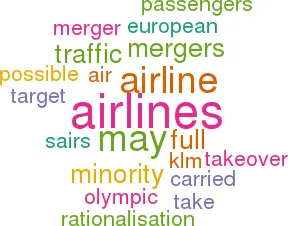Intra-Europe rationalisation now conceivable
June 2000


Following SAir’s nearly full take–over of Sabena (Aviation Strategy, May 2000), a psychological barrier seems to have been breached. Suddenly European airlines are contemplating the prospect of real mergers.
Most explicitly, KLM, whose virtual merger with Alitalia ended in tears, is stating that it is not only anticipating full mergers but also it is accepting the reality that, with its poor financial results, it may have to settle for being the minority partner in a merger. CEO Leo van Wijk commented at the airline’s financial results meeting: "Only true mergers can yield success...any alliance that falls short of that is not our objective."
Potential cross–border mergers in Europe would appear to be possible when the airlines have the following characteristics:
- The target airline has a high proportion of total traffic is intra–EU or within the European economic air space;
- A US open skies agreement is in place for both the country of the acquiring airline and the target airline; and
- Ownership clauses in ASAs with other key countries can be renegotiated (or will not be invoked).
Possible take–over targets in the European scheduled business are listed below. These airlines account for almost 40% of intra–European AEA traffic and 29% of the AEA airlines' North Atlantic traffic (measured by passengers carried). Yet most of them are smaller than US regional airlines (Comair, for comparison, carried 7.0m passengers last year), and in truly commercial market many of them would have been swallowed up by the Euro–majors.
As suggested above, KLM may be up for sale, and BA is rumoured to be the most likely purchaser (though BA itself may be a target for a UK leisure/travel conglomerate). Probably KLM’s biggest asset is its transatlantic traffic, carried under an immunised agreement with Northwest. But that asset would be at risk if BA were to take over KLM, and American take over Northwest) as the competition authorities would surely not countenance such a development.
There may be little commercial logic to Lufthansa and SAS remaining as separate airlines, but SAS continues to exert its independence through, for instance, a re–emphasis on direct long–haul service from Copenhagen, rather than just feeding its Star partner at Frankfurt.
Olympic is an example of an airline that could solve many of its problems through a merger plus route rationalisation. Although only 7 % of its passengers are long–haul (4% transatlantic and a further 3% Australia and South Africa) losses on these routes wipe out the profits it makes elsewhere. BA had the opportunity of investing, but it has stated that it will definitely not take up its option to buy about 20% of Olympic. It was impossible to make an attractive investment case unless the long–hauls were in one way or another transferred to BA, with Olympic feeding at London and Bangkok. That strategy, for local political reasons, was very unlikely to find acceptance in Athens.
Both Lufthansa and SAir have considerable interests in this list of take–over targets, and they are the leading contenders for taking minority stakes in the former East Bloc airlines as they privatise. But these minority stakes do not give full management control, which must be the ultimate aim of the acquisitive Euro–Majors.
SAir’s share price may actually be suffering because of its various minority holdings. It is being discounted against the market for two reasons — first, Swissair is an airline; second, it is perceived by stock–market analysts as a confusing conglomerate. One possibility might be to create a holding company to contain all of SAir’s disparate airline investments until rationalisation is possible — either through moving to full ownership, for example, of TAP or LOT, or through regional consolidation as in the new plan to merge Air Liberté with AOM and Air Littoral.
| Share of total pax | Pax millions | Remarks | |||
| Intra-Europe | N. Atlantic | Both | Total system | ||
| SAS | 95% | 3% | 98% | 21.5 | Full merger with Lufthansa? |
| US open skies | |||||
| KLM | 54% | 18% | 72% | 15.0 | For sale? US open skies |
| THY | 91% | 2% | 93% | 9.9 | Part privatisation planned, |
| Qualiflyer member | |||||
| Sabena | 82% | 8% | 90% | 8.7 | Planned 100% ownership by SAir |
| US open skies | |||||
| Finnair | 92% | 3% | 96% | 6.8 | oneworld member US open skies |
| Olympic | 90% | 4% | 94% | 6.4 | Privatisation mooted, rescue |
| capital needed? | |||||
| British Midland | 100% | 0% | 100% | 6.0 | 20% owned by Lufthansa, |
| 20% by SAS | |||||
| Aer Lingus | 86% | 14% | 100% | 5.5 | Full privatisation this autumn; |
| oneworld member | |||||
| TAP | 84% | 3% | 87% | 4.5 | 34 % owned by SAir US open skies |
| Austrian | 75% | 8% | 83% | 3.4 | 10% owned by Lufthansa after SAir |
| sale | |||||
| Malev | 88% | 3% | 91% | 1.7 | Privatisation planned, |
| seeking trade investor | |||||
| CSA | 82% | 8% | 90% | 1.6 | Privatisation planned, |
| seeking trade investor | |||||
| Cyprus | 86% | 0% | 86% | 1.3 | Privatisation mooted |
| Icelandair | 62% | 38% | 100% | 1.3 | Unique niche |
| Air Malta | 90% | 0% | 90% | 1.2 | Privatisation mooted |
| Balkan | 70% | 3% | 73% | 0.8 | Privatisation mooted |
| Croatia | 99% | 0% | 99% | 0.8 | Privatisation mooted |
| Luxair | 100% | 0% | 100% | 0.7 | 14% owned by Lufthansa |